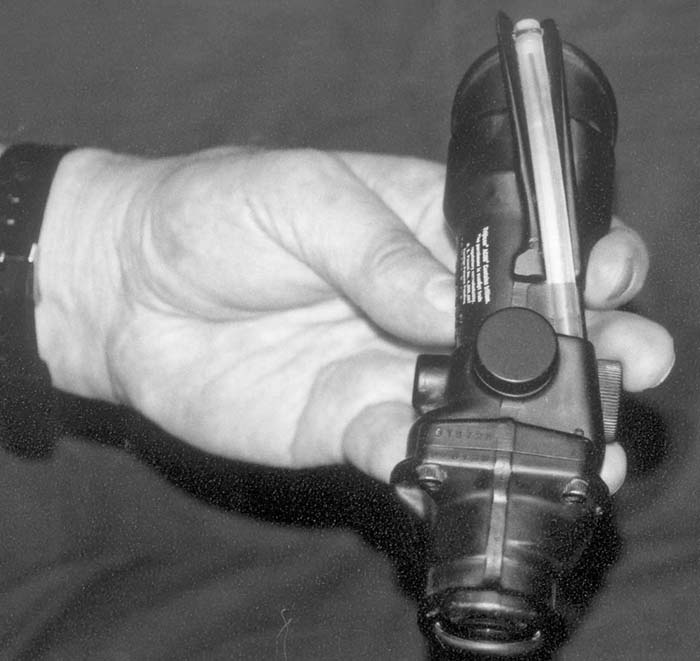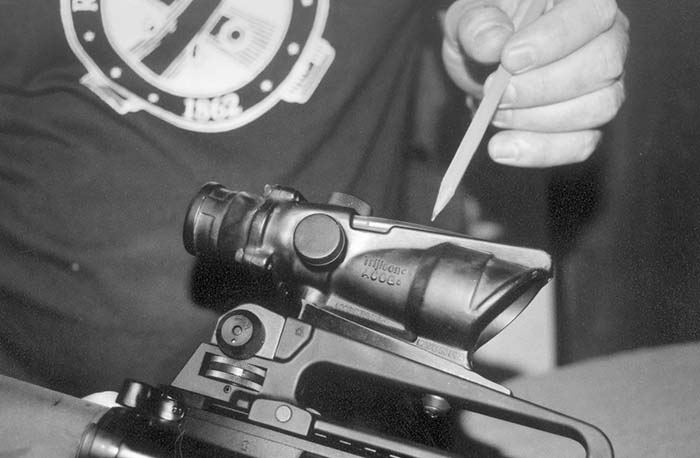The Trijicon ACOG mounted on a Bushmaster XM15E2S Carbine.
by Timothy Kast
“I had to wait approximately six months to get a test unit ACOG to evaluate. Every available piece Trijicon manufactured was being sent to the Middle East for Special Operations use. What does that tell you about the ACOG?”
Trijicon has been the specified manufacturer for Special Operations tritium night sights and specialty scopes for quite some time. The scope housing for the ACOG is forged, not cast, from 7075-T6 aircraft aluminum alloy, and then hard anodized according to military specifications. This is the same process Eugene Stoner used in designing the M16 rifle. It has survived drop tests from heights of 2 meters onto concrete and steel surfaces.
The Bindon Aiming Concept (or BAC) is unusual in that it allows close quarters transitional aiming with traditional long distance marksmanship. This is achieved by employing two-eye open aiming and a magnifying optical system together with a glowing reticle. This glowing reticle illuminated by the fiber optic system enhances the overall speed and accuracy with which the human eye tracks and configures the reticle.
The BAC discovery was made after an exhaustive search to combine the speed of an Armson OEG and similar red dot collimator sights together with the precision accuracy of a conventional telescopic riflescope. The BAC principle is simple, it is the automatic reaction of the human eye; it occurs instinctively. You must keep both eyes open all the time. The neon red reticle functions in the daytime hours, then adds a sharp contrast for transition to low light conditions. Upon receiving a target, you raise your weapon and point it in the general direction of the target. You will see the fiber-optic-illuminated reticle as you position your scope into the target area. Your M16 should then be in proper alignment with the target. Your brain then reacts and switches to the magnified view for your final exact telescopic picture. It sounds complicated, but it usually occurs within split seconds for complete target acquisition. The ACOG 4x32BAC is enabled by the fiber optic system and so is always illuminated no matter what lighting conditions may be present. You will see a sharp contrast with which to make your final sight picture. Your eyes will compensate for each other automatically as the weapon is moved, choosing the non-blurry magnified image routinely over the blurry image. As you slow the movement of your weapon, your brain will instantly choose the greater detail of the clearer magnified sight picture. This is a normal reaction designed to give you an uninterrupted view of your target.

The idea behind the use of the fiber optic system was to provide the best possible illuminated riflescope without unwanted complexity or reliability problems. There are no batteries, moving parts, switches or solar cells with this product. It is designed to be self sufficient and reliable under all conditions and in any environment.
The ACOG also contains tritium or Hydrogen-3, as it is also known. This is a commonly used radioactive material for nighttime illumination. This gives the riflescope its ability to work day or night, since the majority of enemy operatives seldom work a 9-5-work day.
I mounted the ACOG on a regular AR-15 for testing and evaluation. The mounting screws (1/32 x 1/2-inch allen buttonhead screws) are supplied, as is an Allen wrench. The scope utilizes the standard mounting hole centered on the carry handle or most AR-15s, so drilling holes in your weapon is not required. They even offer an optional thumb screw (part no. TA53) for a swift release from the carry handle. There is a second threaded hole on the bottom of the mount should you desire to permanently mount the scope or just want some additional security or rigidity. I noticed too, that the mount includes a clear channel to utilize the original iron sights should you need a point of reference in zeroing in the ACOG.
Trijicon states that the adjustment process varies slightly from other scopes and that adjustments are made in increments of 1/3 inch per click at 100 yards. This requires you to use 3 clicks to move the bullet one inch on your final target. The adjustment recesses are clearly marked with arrows for the direction that they must be moved to effect a change downrange in the same direction. The reticle is gauged so that the scope is zeroed at 100 yards with the top most reticle being the point of aim. Once zeroed at this range, you do not need to make any further adjustments between shots at different ranges.
In dry practice, the floating red donut leads your attention when the weapon is scanned in rapid sequence; then the next thing you notice is the ranged reticle beneath it. The Trijicon is always ready to use. No fumbling with a finicky pressure pad switch or cursing dead batteries. It has light gathering capabilities that excel in shadowy low light that you just don’t find otherwise. The fluorescent red donut is always on and always there. While the Bindon Aiming Concept takes a slight adjustment period, it is easily adopted. The most astonishing feature you will find is the speed at which you will acquire your target. This translates to a greater confidence in your weapon/scope combination.

My test unit was the 4×32 (TAO1NSN) that is presently being used by Special Operations Command (SOCOM) as standard issue for all Special Operations Units: this carries a national Stock Number of NSN1240-01-412-6608. This type of scope was engineered for the rough treatment many Spec-Ops weapons undergo. The ACOG features an internal adjustment that allows the shock load received in combat to be absorbed by the shock body and not the adjustment system.
I have owned Armson OEG scopes in the past and have found them to be very innovative and reliable. Trijicon now owns Armson and the ACOG is representative of the aggressive nature of their research and development sector. Their tritium sights are widely accepted among SOCOM groups, and they invited military input into the BAC version of the ACOG. The ACOG 4×32 was tested in the Advanced Combat Rifle (ARC) program conducted by the United States Army in 1989. Installed on the M16 it became the benchmark throughout the testing and was also mandated by other government contractors on their proposed advanced weapon systems. The ACOG has gone on to be used successfully by Spec-Ops units in conflicts such as El Salvador, Panama, and Desert Storm. Products as the ACOG are tested literally under fire, giving the operator little doubt as to its worth.
Along with the Army’s testing, Trijicon worked extensively with the University of Rochester Center for Visual Science as well as the University of Michigan Department of Opthalmology. Their research revealed that 96% of the population can use the BAC feature readily, while only 4% of the population had trouble with the system. These 4% were diagnosed as having phoria, a condition where the eyes wander off to either side rather than focusing correctly ahead. Phoria is measured in prism diopters. Most people have some small values of phoria, but not enough to significantly reduce their ability to focus with both eyes on a target in front of them. The customary way of addressing a two-eyes-open scope is to look through the reticle into the distance. Your eyes will look slightly towards each other as if they were a bit crossed. When we read, our eyes move even closer together. If one eye is blocked, it does not receive the same sensory input and will wander away from the target, usually to one side or the other. Testing has proven approximately 45% of the populace has absolutely zero phoria. If you discover that you exhibit symptoms of phoria or happen to be blind in one eye, you can still use an ACOG scope by simply switching to one-eye-only vision for looking through the telescopic sight. Phoria can also influence the red aiming donut a marginal amount left or right of the final aim dependent of your level of phoria.
As mentioned earlier, the ACOG scope contains a small amount of radioactive material for nighttime illumination. Tritium is a naturally occurring odorless, tasteless, colorless gas that reacts similarly as natural hydrogen to the human body. The body cannot easily retain either hydrogen or tritium as a gas. It is the flame ignition of this gas that is hazardous. If a tritium lamp becomes broken or is suspected of leakage, use caution around any source of flame until the manufacturer can repair the unit properly.
Maintenance and care for the ACOG are pretty simple, wash it with a little soap and water if it gets dirty. That’s it. Once clean, the lens of the ACOG can be polished with a soft cloth for greater clarity if you choose.
After testing and evaluation on the ACOG, I felt it was well worth the wait. I finally got a chance to check out a cutting edge military riflescope designed specifically for the AR-15, M16, M4 carbine family of weapons. It’s a rough and tumble scope that thrives on abuse. It comes with a manual, fasteners, Allen wrench, scope cover and even a polyethylene hard case for travel or storage. If you own an M16 or an AR-15, you will find it to be an excellent investment for your firearm.
Trijicon, Inc.
Dept. SAR
49385 Shafer Avenue
P.O. Box 930059
Wixom, MI 48393
Toll free: 800-338-0563
Website: www.trijicon.com
Email: info@trijicon.com
| This article first appeared in Small Arms Review V7N10 (July 2004) |











